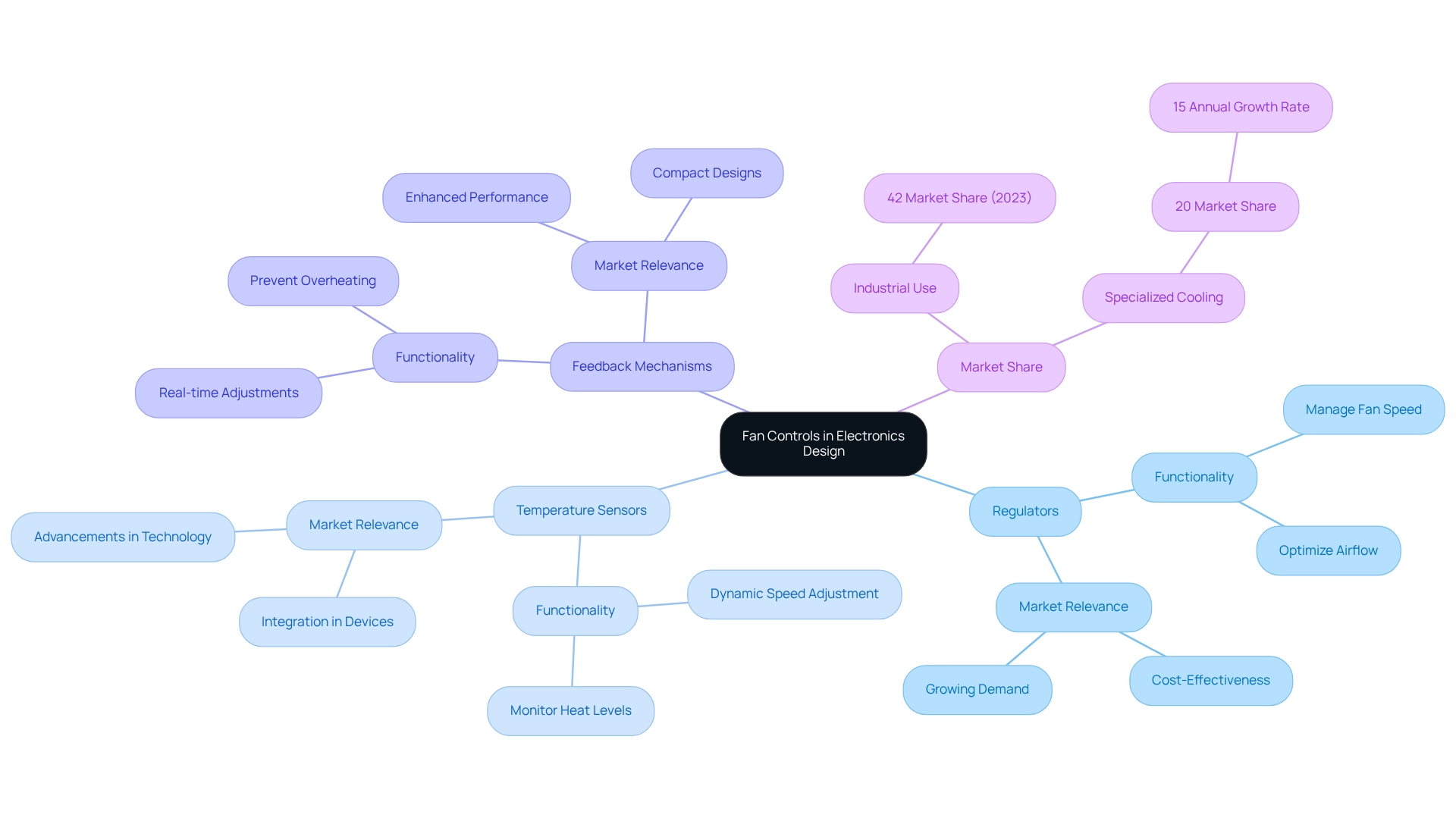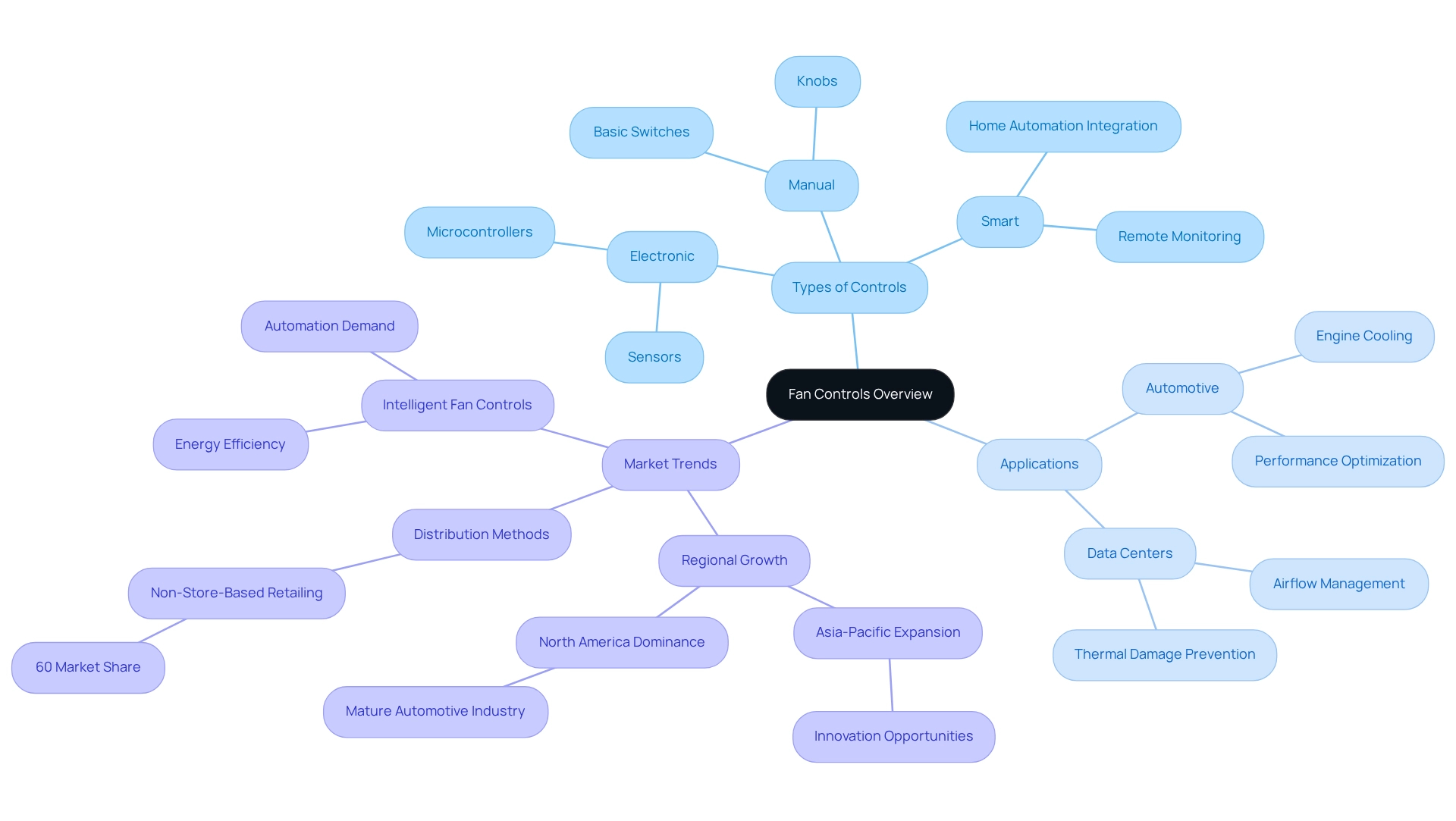Overview
This article delves into the pivotal features and applications of fan controls, underscoring their critical function in regulating cooling and ventilation across diverse electronic systems. It elucidates how technological advancements, particularly Pulse Width Modulation (PWM) and smart connectivity, significantly bolster the efficiency and adaptability of fan controls. These enhancements are essential for mitigating overheating and optimizing performance in key sectors, including automotive and data centers, where reliable thermal management is paramount.
Introduction
In the dynamic realm of electronics, fan controls are pivotal for optimizing device performance and longevity by effectively managing cooling and ventilation. As technology has evolved, these systems have transitioned from basic mechanical switches to sophisticated electronic and smart controls, incorporating features that enhance energy efficiency and user convenience. With the global market for fan controls expanding—particularly in developing regions—grasping their key components, applications, and advancements is essential for anyone invested in modern engineering. This exploration delves into the intricacies of fan control systems, underscoring their significance across various industries, including automotive and data centers, while examining the latest trends that are shaping their future.
Define Fan Controls: Essential Components in Electronics Design
Regulators serve as crucial components in managing the operation of blowers within electronic applications, ensuring optimal cooling and ventilation across diverse environments such as computers, HVAC systems, and industrial machinery. These mechanisms adeptly regulate fan controls, such as fan speed and airflow, which are essential for maintaining the efficiency and longevity of electronic components. As electric ventilators become increasingly cost-effective compared to air conditioning units, their market presence is expanding, particularly in emerging regions.
Key components of ventilator management encompass temperature sensors, regulators, and feedback mechanisms. A typical fan controls system utilizes temperature sensors to monitor heat levels generated by electronic components. This data empowers the mechanism to dynamically adjust rotor speed, thereby maintaining optimal operating conditions and preventing overheating.
Gagner-Toomey Associates, recognized as the world’s largest manufacturer of standard and custom air-movers, provides an extensive product range of DC input tube axial devices and centrifugal blowers, all optimized for performance, efficiency, and minimal noise. Their offerings vary in size from 15mm to 280mm for tube axial fans and from 15mm to 225mm for centrifugal blowers, ensuring effective thermal management across various devices, particularly in electronics and automotive applications. Recent advancements in fan controls technology at Gagner-Toomey Associates have resulted in the creation of more compact and efficient systems, significantly enhancing the overall performance of their cooling solutions. The demand for these technologies is projected to grow substantially, driven by technological advancements and infrastructure development. In 2023, the industrial use segment of fan mechanisms represented over 42% of the market share, underscoring their importance in a multitude of applications. As noted by Yogesh Shinde, this segment has exhibited considerable strength, emphasizing the critical role of fan management within the industry. Furthermore, the segment dedicated to specialized cooling technologies, which includes mixed-flow and cross-flow devices, constitutes approximately 20% of the industry and is experiencing a steady growth rate of 15% annually. This trend indicates a rising need for tailored cooling solutions in specialized markets, such as medical devices and compact electronic equipment. In summary, the integration of advanced fan controls, including those offered by Gagner-Toomey Associates, is vital for enhancing the efficiency and reliability of electronic designs. These systems ensure that devices operate within safe temperature ranges, ultimately improving product performance. For further information on Gagner-Toomey Associates’ innovative cooling solutions, please visit their website or reach out to them directly.

Explore the Evolution of Fan Controls in Electronics
The development of fan mechanisms has its origins in simple mechanical switches that activated electric fans. As technology advanced, electronic systems emerged, facilitating more sophisticated management of fan controls. A pivotal moment in this evolution was the introduction of pulse-width modulation (PWM) technology, which enabled precise regulation of fan speed while significantly reducing energy consumption. Statistics indicate that PWM technology can yield energy savings of up to 30% compared to conventional management methods—a figure supported by numerous industry studies that underscore its efficiency.
Today, fan controls have evolved to incorporate smart technologies, including IoT connectivity and machine learning algorithms, allowing for adaptive management based on real-time environmental conditions. For instance, modern fan management systems can adjust their operations based on temperature and humidity data, optimizing performance and energy use. This progression not only highlights historical trends in the development of fan controls technology but also aligns with a broader industry shift towards energy efficiency and automation.
Regulatory frameworks promoting sustainability are influencing industry trends, as illustrated in the case study titled ‘Impact of Regulatory Frameworks on the Fan Controller IC Sector.’ This research demonstrates how such regulations are fostering innovation and encouraging manufacturers to adopt eco-friendly solutions, emphasizing the significance of PWM technology in contemporary fan management systems. Moreover, confidentiality issues restrict the sharing of all sources referenced during market research, which can impact the accessibility of comprehensive information on trends in fan management technology.

Examine Key Features and Functions of Fan Controls
Fan controls in modern designs are equipped with several key features that significantly enhance their functionality and efficiency. Among these, variable speed settings stand out, allowing users to tailor fan speeds to specific cooling requirements. This adaptability can result in substantial energy savings, as fan controls allow devices to operate only at the required speed for the current thermal load. Notably, fans utilizing DC motors are more efficient than traditional AC motors, contributing further to energy savings and quieter operation. Temperature sensors play an essential role in this process by providing real-time feedback to the management framework, which includes fan controls that facilitate automatic adjustments and enhance performance according to environmental conditions.
Furthermore, numerous modern fan controls incorporate remote operation features, often accessible through mobile applications or integrated into smart home setups. This capability enables users to manage their fans effortlessly from any location, further enhancing user comfort and operational efficiency. As one individual, referred to as ‘The Exacting Consumer,’ remarked, “Having possessed the fan for just over a year, my experience overall has been positive,” underscoring the practical advantages of these advanced features. By ensuring that fans operate only when needed, these systems contribute to the overall effectiveness of electronic systems, making them an essential component in modern engineering applications. Moreover, understanding the distinctions between AC and DC motors, as discussed in the case study titled ‘Motor Type (AC vs. DC),’ empowers consumers to make informed decisions based on their budget and energy efficiency needs.

Identify Different Types of Fan Controls and Their Applications
Fan mechanisms serve as critical components across various applications, classified into manual, electronic, and smart categories. Manual mechanisms, such as basic switches or knobs, empower users to adjust fan speeds directly. Conversely, electronic mechanisms, commonly found in computers and HVAC systems, leverage sensors and microcontrollers to automate fan operations based on real-time temperature readings. Intelligent systems further enhance functionality by integrating with home automation networks, enabling users to monitor and adjust settings remotely via smartphones.
The applications of fan management are extensive, particularly within the automotive and data center sectors. In automotive contexts, fan adjustments play a vital role in regulating engine cooling, thereby ensuring optimal performance and preventing overheating. Data centers rely on these controls to manage airflow efficiently, safeguarding servers from thermal damage. Each type of fan control provides distinct advantages tailored to specific operational requirements, making them indispensable in modern electronic systems.
Current industry trends reveal a significant shift towards intelligent fan controls, driven by an increasing demand for automation and energy efficiency. The water cooling fan controller segment notably captured a substantial share of the global engine cooling fan controller market in 2023, reflecting the growing importance of advanced cooling solutions. This segment accounted for a significant portion of the industry, underscoring its relevance.
As the Asia-Pacific region continues to expand rapidly, opportunities for innovation in fan management technologies are on the rise, particularly as non-store-based retailing has emerged as the primary distribution method in the electric fan market, claiming over 60% share in 2023. This trend highlights the essential role of fan controls in the dynamic landscape across various sectors. Furthermore, the Industrial Use segment demonstrated considerable strength, representing over 42% of the market share in 2023, indicating robust demand in this area. A regional market analysis reveals North America’s dominance while also acknowledging the swift growth of Asia-Pacific, offering a comprehensive overview of the market landscape and innovation opportunities.

Conclusion
The exploration of fan controls underscores their pivotal role in optimizing performance and extending the lifespan of electronic devices across diverse industries. From fundamental mechanical switches to sophisticated electronic and smart systems, the evolution of fan controls has markedly enhanced energy efficiency and user convenience. Essential components such as temperature sensors and PWM technology are crucial for achieving precise control and significant energy savings, exemplifying how innovation propels the industry forward.
Moreover, the varied applications of fan controls in sectors like automotive and data centers emphasize their indispensable role in contemporary engineering. As the market expands, particularly in developing regions, the demand for specialized cooling solutions and smart technologies is surging. This shift not only mirrors evolving consumer preferences but also aligns with the broader trend towards automation and energy efficiency.
Ultimately, grasping the complexities of fan control systems is vital for professionals engaged in electronics design and engineering. By adopting these advancements, stakeholders can secure optimal cooling solutions that enhance device performance while contributing to a sustainable future. The journey of fan controls continues, with promising developments on the horizon that are set to further transform the management of cooling and ventilation in electronic applications.
Frequently Asked Questions
What is the role of regulators in electronic applications?
Regulators manage the operation of blowers, ensuring optimal cooling and ventilation in environments such as computers, HVAC systems, and industrial machinery by controlling fan speed and airflow.
How do temperature sensors contribute to fan control systems?
Temperature sensors monitor heat levels generated by electronic components, allowing the fan control system to dynamically adjust rotor speed to maintain optimal operating conditions and prevent overheating.
Who is Gagner-Toomey Associates and what do they offer?
Gagner-Toomey Associates is the world’s largest manufacturer of standard and custom air-movers, providing a wide range of DC input tube axial devices and centrifugal blowers optimized for performance, efficiency, and minimal noise.
What sizes are available for Gagner-Toomey Associates’ fans?
Tube axial fans range in size from 15mm to 280mm, while centrifugal blowers range from 15mm to 225mm.
What recent advancements have been made in fan controls technology?
Recent advancements have led to the development of more compact and efficient fan control systems, significantly enhancing the overall performance of cooling solutions.
What is the market share of the industrial use segment of fan mechanisms in 2023?
In 2023, the industrial use segment represented over 42% of the market share for fan mechanisms.
What is the growth rate of the specialized cooling technologies segment?
The specialized cooling technologies segment, which includes mixed-flow and cross-flow devices, is experiencing a steady growth rate of 15% annually.
Why is fan management critical in various industries?
Fan management is essential for ensuring devices operate within safe temperature ranges, ultimately improving product performance and reliability in applications such as medical devices and compact electronic equipment.

